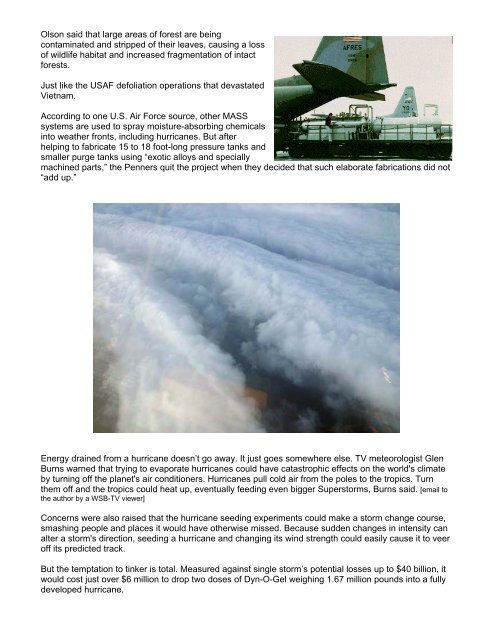CHEMTRAILS%20-%20CONFIRMED%20-%202010%20by%20William%20Thomas
CHEMTRAILS%20-%20CONFIRMED%20-%202010%20by%20William%20Thomas
CHEMTRAILS%20-%20CONFIRMED%20-%202010%20by%20William%20Thomas
Create successful ePaper yourself
Turn your PDF publications into a flip-book with our unique Google optimized e-Paper software.
Olson said that large areas of forest are being<br />
contaminated and stripped of their leaves, causing a loss<br />
of wildlife habitat and increased fragmentation of intact<br />
forests.<br />
Just like the USAF defoliation operations that devastated<br />
Vietnam.<br />
According to one U.S. Air Force source, other MASS<br />
systems are used to spray moisture-absorbing chemicals<br />
into weather fronts, including hurricanes. But after<br />
helping to fabricate 15 to 18 foot-long pressure tanks and<br />
smaller purge tanks using “exotic alloys and specially<br />
machined parts,” the Penners quit the project when they decided that such elaborate fabrications did not<br />
“add up.”<br />
Energy drained from a hurricane doesn’t go away. It just goes somewhere else. TV meteorologist Glen<br />
Burns warned that trying to evaporate hurricanes could have catastrophic effects on the world's climate<br />
by turning off the planet's air conditioners. Hurricanes pull cold air from the poles to the tropics. Turn<br />
them off and the tropics could heat up, eventually feeding even bigger Superstorms, Burns said. [email to<br />
the author by a WSB-TV viewer]<br />
Concerns were also raised that the hurricane seeding experiments could make a storm change course,<br />
smashing people and places it would have otherwise missed. Because sudden changes in intensity can<br />
alter a storm's direction, seeding a hurricane and changing its wind strength could easily cause it to veer<br />
off its predicted track.<br />
But the temptation to tinker is total. Measured against single storm’s potential losses up to $40 billion, it<br />
would cost just over $6 million to drop two doses of Dyn-O-Gel weighing 1.67 million pounds into a fully<br />
developed hurricane.


